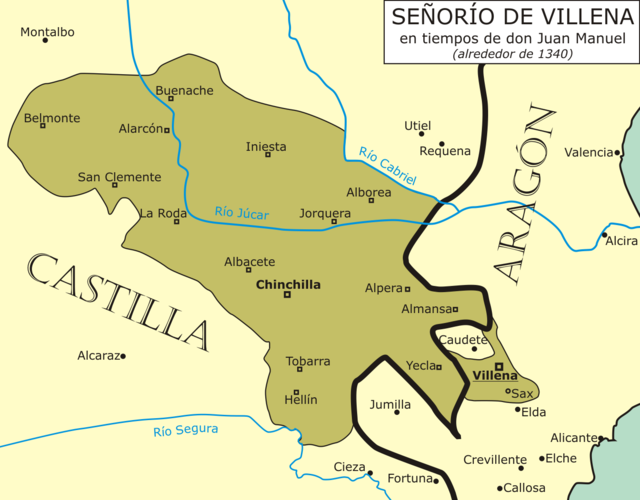Top Qs
Timeline
Chat
Perspective
Lordship of Villena
Medieval Lordship in Spain From Wikipedia, the free encyclopedia
Remove ads
The Lordship of Villena (Spanish: Señorío de Villena) was a feudal state located in southern Spain, in the kingdom of Castile.[1] It bordered to the north with Cuenca and to south with the city of Murcia.

Remove ads
Territory
Summarize
Perspective
Initially, the lordship included the towns and cities from the coasts of Elche and the entire territory of the Vinalopó River, extending even to the valley of Ayora and Cofrentes. Over time it would end up covering a good part of the current provinces of Alicante, Albacete, Murcia, Valencia and Cuenca, representing de facto since its creation a true buffer state between the Crowns of Castile and Aragon.
Lately, the territory was structured in two political centers: the Land of Alarcón, to the north, and the Land of Chinchilla to the south. Less central were the towns of Iniesta, the Land of Jorquera, Hellín, Tobarra, Almansa, Yecla, Sax and Villena, which, despite giving the name to the lordship, was territorially peripheral, although it previously included the cities along Vinalopó river (Sax, Elda, Novelda, Elche). The borders changed with the time, provided the temporary addition of some towns (Villarrobledo, Lezuza, Munera, Jumilla and Utiel in the 15th century) and the loss of some other towns.[1]
The lordship has a double historical origin. On the one side, the towns and villages of the Land of Jorquera, Hellín, Ves, Tobarra, Almansa, Yecla, Sax and Villena were owned by Infante Manuel of Castile, so it began to be called the Land of don Manuel. On the other side, the Land of Alarcón and Iniesta belonged to the crown during the 12th and 13th centuries, being incorporated to the lordship by Juan Manuel, Prince of Villena,[1] who had a very wide jurisdiction in his land and made it become a Duchy and, finally, a Principality.[2]
Remove ads
Duchy and Principality of Villena
Upon the death of Don Manuel, the manor was inherited by his son, Don Juan Manuel, second lord, prince and first duke of Villena. It was he who would expand the manor and lead it to its period of greatest splendour, acquiring with his possessions an autonomy practically comparable to that of the peninsular kingdoms, playing with its border situation between Castile and Aragon. This phase of great power and autonomy would lead him to elevate the title to Duchy and even to a lifelong Principality, going so far as to mint his own currency or maintain a personal retinue of more than a thousand knights.
The Duchy returned to the Crown in 1366 after his only son Fernando Manuel had no male offspring.
The title of Marquess of Villena was giving to Alfonso I, Duke of Gandia, but this title returned to the Crown in 1385 when his son Pedro was killed in the Battle of Aljubarrota.
In the XV century the title of Duke of Villena was recreated and taken away several times, until it returned to the Crown in 1445.
Finally, the title of Marquess of Villena was recreated in 1445 for Juan Pacheco and still exists today.
Remove ads
List of holders
References
Bibliography
Wikiwand - on
Seamless Wikipedia browsing. On steroids.
Remove ads

